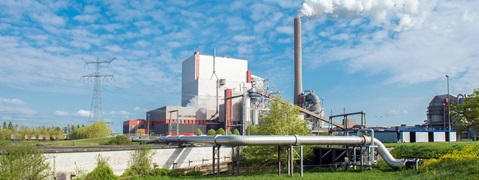| Location of power plant | Geertruidenberg, the Netherlands |
| Type of power plant | Biomass and coal-fired power plant |
| Commissioned | 1993 |
| Fuel | Biomass (80%) and coal (20%), mass-based |
| Output (net) | 600 MW of electricity and 350 MW of heat |
| Flue gas cleaning | Electrostatic filters, denitrification and flue gas desulphurisation plant |
Electricity and heat
For a long time, coal and gas were the main fuels used for the power plants at this site. The current power plant – unit 9 – has been in operation since 1993 and produces electricity and heat. Coal has since been replaced by sustainable biomass to a large extent.
The unit has sufficient capacity to generate electricity for around one million households. The heat that is produced in the same unit is used to heat greenhouses in the Plukmade Polder area in Drimmelen and supplies Geertruidenberg and parts of Breda and Tilburg with district heat. Since May 2018, the Amer power plant has also had a solar farm.
From coal to biomass
Various types of biomass have been tested and used at the Amer power plant since the 1990s. Back then, this was still being carried out in two units, 8 and 9. At the end of 2020, a brand new biomass logistics facility was put into operation, with closed conveyor belts. This has made it possible to switch the unit almost completely to biomass.
Biomass is supplied in the form of wood pellets (compressed sawdust) and delivered via inland waterways. The Amer power plant has a special biomass unloading quay for processing wood pellets where biomass can be stored in various silos. After being sucked from the hold by two unloaders on the quay which act like vacuum cleaners, the pellets are then transported to the silos on a conveyor belt.
From there, the pellets are transported further via either closed conveyor belts or a pneumatic system (as an external unit).
Products and by-products
During the combustion process in the boiler, pieces of ash are created which collect on the floor of the boiler. This so-called bottom ash is dried and used as a foundation layer under motorways or sports pitches, for example.
The lighter ash particles which rise up in the direction of the flue are trapped electrostatically and collected. This so-called fly ash has cement-like properties which is why it is used in the concrete and cement industry as a replacement for mineral cement.
A final wet cleaning of the flue gases using limestone and water removes the sulphur dioxide, leaving gypsum of extreme purity. This so-called flue gas desulphurisation gypsum (fgd gypsum) is used to make gypsum boards, for example.
So using biomass and coal as fuel, the power plant produces electricity and heat, along with bottom ash, fly ash and gypsum as by-products.
